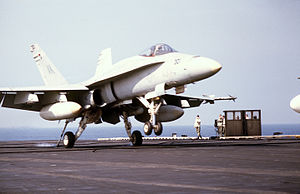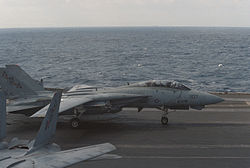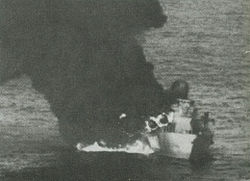- Action in the Gulf of Sidra (1986)
-
Action in the Gulf of Sidra (1986)
A VMFA-314 F/A-18A lands on USS Coral Sea (CV-43).Date March, 1986 Location Libya Result Tactical US Victory Belligerents  United States
United States Libya
LibyaCommanders and leaders Ronald Reagan Muammar al-Gaddafi Strength 30 warships
225 aircraft2 missile corvettes
3 patrol boatsCasualties and losses None 1 corvette sunk
1 patrol boat sunk
1 corvette damaged
1 patrol boat damaged
SAM sites damaged
or destroyed
35 killed[1]Clashes between Libya and the United States- 1st Gulf of Sidra
- Gulf of Sidra (naval)
- 1986 Berlin bombing
- 1986 bombing of Libya
- 2nd Gulf of Sidra
- 2011 bombing of Libya
In the Action in the Gulf of Sidra, the United States Navy deployed aircraft carrier groups in the disputed Gulf of Sidra in the Mediterranean Sea. Libya claimed that the entire Gulf was their territory, at 32° 30' N, with an exclusive 62 nautical miles (115 km) fishing zone.[2] Libyan leader Muammar al-Gaddafi asserted this in 1973 and dubbed it The Line of Death. The United States claimed its rights to conduct naval operations in international waters, a standard of 12-nautical-mile (22 km) territorial limit from a country's shore.
Contents
Background
Tensions between the United States and Libya heightened after the hijacking of TWA Flight 847 on 14 June 1985 and the Rome and Vienna airport attacks on 27 December that same year. The United States claimed that the Libyan leader was involved in these actions through his support of the alleged perpetrator, Palestinian terrorist Abu Nidal.[citation needed] At the same time Libya began the installation of SA-5 surface-to-air missile batteries and radars they received from the Soviet Union in late 1985, to bolster their air defense. As the US Navy had done for several years, they continued to challenge Libya’s claim to the Gulf of Sidra by crossing the so-called "Line of Death." Following the terrorist attacks in Rome and Vienna, the US Navy began several "Freedom of Navigation" operations in the area around Libya in an operation named "Attain Document", the first two parts of the operation being held from January 26–30, and February 12–15 without incident. The third part of the operation began on March 23 with an armada from the United States Sixth Fleet consisting of three aircraft carriers - USS America (CV-66), USS Coral Sea (CV-43) and USS Saratoga (CV-60); five cruisers, six frigates, 12 destroyers, 250 aircraft and 27,000 personnel conducting three carrier operations near the gulf. The USS Detroit (AOE-4) and the USS Savannah (AOR-4) were the fuel, ammunition and combat stores (Food and supplies) replenishment ships that supplied the entire battle group.[citation needed]
According to US Secretary of State George P. Shultz, America's position was quite clear; there would be no restriction on US naval movements through international waters. By crossing the "Line of Death", American forces were asserting their right to keep international sea lanes open and "conduct naval and air exercises in every part of the globe." During the operations held in January and February, the United States Navy had made 130 intercepts of Libyan fighters in the airspace over the Gulf of Sidra, although neither side opened fire. Gaddafi had threatened to shoot down or destroy US aircraft or ships moving over the "Line of Death", but during the 32 days prior to hostilities there were no incidents. Soviet Tu-16 Badgers overflew the US fleet on several occasions, but were led away by fighter escorts.[citation needed]
Hostilities
On 23 March 1986, US aircraft from the three carriers crossed the "Line of Death" and began operating in the Gulf. On 24 March at 06:00, USS Ticonderoga (CG-47), accompanied by two destroyers, USS Scott (DDG-995) and USS Caron (DD-970), moved south of the "Line", covered by fighter aircraft. A Libyan missile installation near Surt (Sirte) launched two Soviet-made SA-5 "Gammon" surface-to-air missiles (SAMs) at 07:52, toward F-14A Tomcats of America's VF-102. Two hours later, two MiG-23s took off from Benina air base with orders to intercept and shoot down some of the US fighters.[3] Before the Libyan aircraft could get close enough, a US E-2C Hawkeye detected them and alerted two F-14s from VF-33, which intercepted the MiGs at 20,000 feet (6,100 m). The Libyans began aggressive head-on maneuvering in an effort to get into firing positions on the two F-14s; this was a clear sign of hostile intentions.[citation needed]
The F-14 wing leader reported "excessive hostile actions and intentions", which led the air warfare commander aboard the USS America to give the pilots the signal "warning yellow, weapons hold"; this meant the F-14s could open fire if necessary. An intense dogfight ensued, though without any missiles being fired. The F-14s dropped to 5,000 feet (1,500 m) where they had a distinct advantage over the MiG-23s and positioned themselves between the sun and the Libyans. The F-14s moved into a six o'clock position behind the hostile MiGs, locked on to them with radar and acquired AIM-9 Sidewinder tones, which meant they were ready to shoot the Libyans down. The MiGs moved off, seeming to follow a return course to their base. However, one of them reversed course, turning against the F-14s; the F-14 wing leader acquired the MiG, and requested permission to open fire. Before permission could be granted, the MiG-23 turned away and headed south. At the same time, F-14s from VF-102 were patrolling some 40 kilometres away from the Libyan coast (still over international waters) and were fired upon by SA-5 surface-to-air missiles from the coastal town of Surt. The missiles missed their F-14 Tomcat targets and fell harmlessly into the sea. Two additional SA-5s were launched but were jammed by an EA-6B Prowler.[citation needed]
An F-14 from VF-74 lands on USS Saratoga
Several Libyan patrol boats headed out towards the US battle group, and the Americans responded by sending up aircraft to counter them. The USS Saratoga launched A-7 Corsair II aircraft armed with HARM missiles from Strike Fighter Squadron VA-83, A-6 Intruder aircraft armed with Harpoon missiles and cluster bombs from VA-85 and EA-6Bs from VAQ-132. USS America had A-6Es from VA-34 and EA-6Bs from the Marine squadron VMAQ-2 and USS Coral Sea had A-6Es from VA-55 and EA-6Bs from VAQ-135 in the air; these were supported by several E-2Cs, F-14s, F/A-18s and KA-6Ds. The first air strikes occurred around 19:26 when two A-6 Intruders from VA-34 found a French-built FACM Class La Combattante IIa patrol boat; the ship was first disabled by a Harpoon missile fired by one of the A-6 Intruders from VA-34 (the first combat use of the Harpoon) and then destroyed by Intruders from VA-85 using Rockeye cluster bombs.[4][5] Forty minutes later, F-14s, F/A-18s, A-7Es and EA-6Bs headed towards the SA-5 site near Surt at low level and suddenly climbed, which caused the Libyans to activate their radars and launch missiles at the incoming aircraft; this prompted the A-7Es to launch several HARM missiles. The strike formation then descended to 30 meters above sea level and turned back. It is unknown if any of the US missiles struck their intended targets, but A-6Es from VA-86 and VA-55 turned to engage several Libyan missile boats. At around 2155, two A-6Es from VA-55 attacked a Nanuchka-class corvette which was heading towards the USS Yorktown (CG-48), prompting USS Richmond K. Turner (CG-20) to open fire with a Harpoon missile that struck the Libyan vessel and subsequently started a fire; the corvette survived the attack and was towed back to Benghazi.[citation needed]
At approximately midnight, the Libyans launched several SA-2s and SA-5s, this time at the American A-6Es and A-7Es, which responded by heading towards the coast. A-7Es from VA-83 launched HARM missiles, disabling several Libyan radars. Three more SA-5s were launched from Syrte with a single SA-2 launched near Benghazi. At 0730 another Libyan corvette was intercepted by A-6Es from VA-55 and was disabled by Rockeye munitions; the corvette was later sunk by a Harpoon missile launched from a VA-85 A-6E. The operation was terminated after this strike with no losses to the Americans; 35 seamen were killed and there were an unknown number of matériel losses to the Libyans.[citation needed]
Notes
External links
Categories:- Conflicts in 1986
- Naval battles involving the United States
- Naval battles post-1945
- 1986 in the United States
- Military history of Libya
- Libya–United States relations
- 1986 in Libya
Wikimedia Foundation. 2010.




